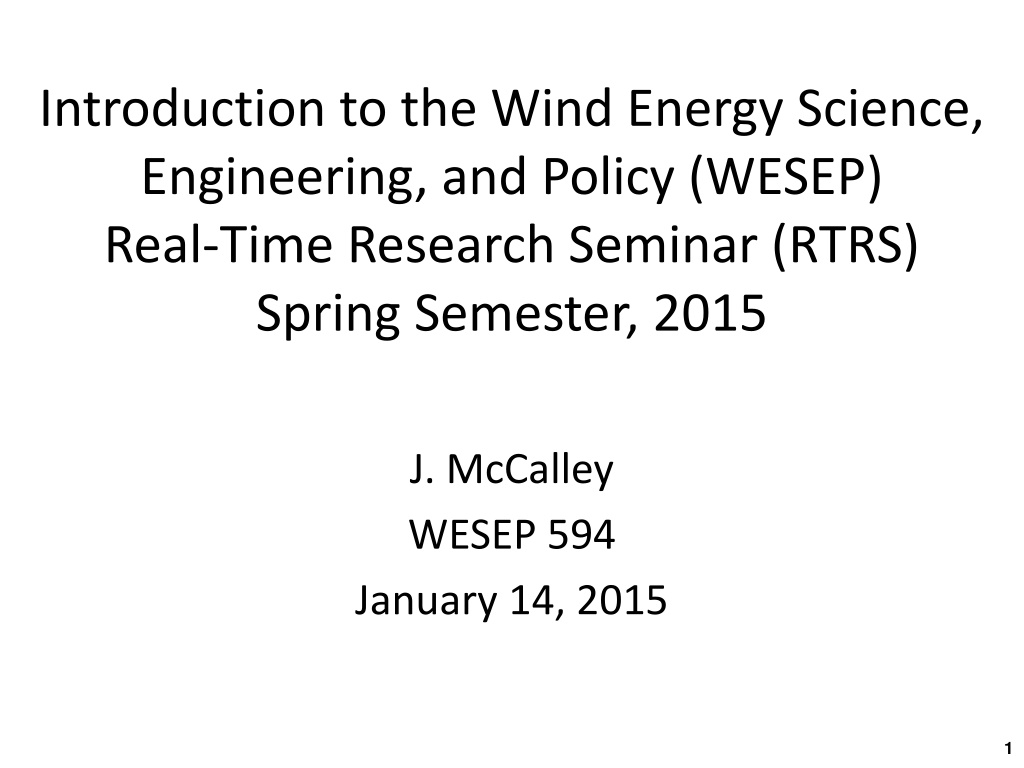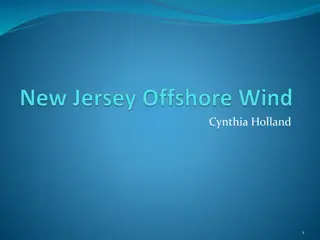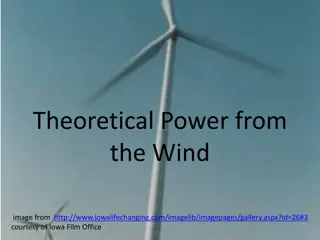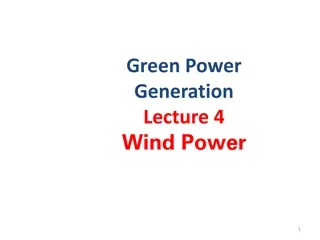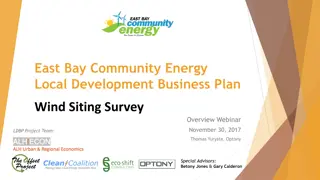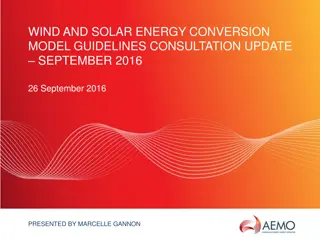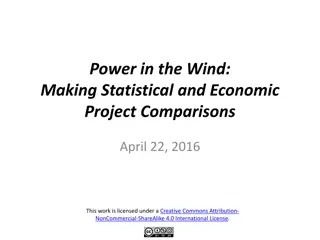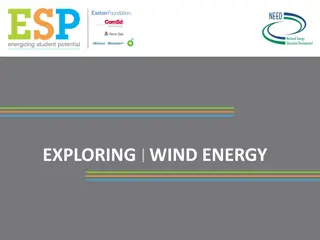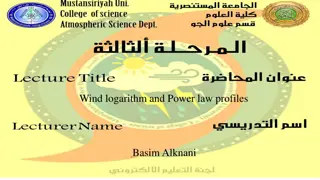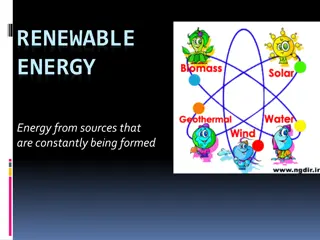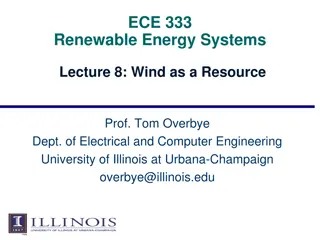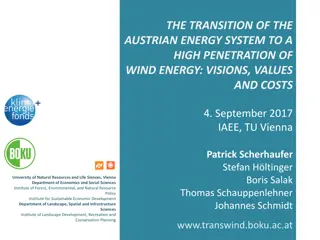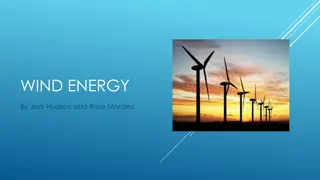Wind Energy Research Seminar Overview
Explore the Wind Energy Science, Engineering, and Policy (WESEP) Real-Time Research Seminar that delves into student presentations, international opportunities, conference attendance, paper writing, and hands-on lab experiences. Dr. McCalley encourages in-depth presentations, external speakers, and collaborations in the wind energy field, fostering a dynamic learning environment for students interested in wind energy research.
Download Presentation

Please find below an Image/Link to download the presentation.
The content on the website is provided AS IS for your information and personal use only. It may not be sold, licensed, or shared on other websites without obtaining consent from the author. Download presentation by click this link. If you encounter any issues during the download, it is possible that the publisher has removed the file from their server.
E N D
Presentation Transcript
Introduction to the Wind Energy Science, Engineering, and Policy (WESEP) Real-Time Research Seminar (RTRS) Spring Semester, 2015 J. McCalley WESEP 594 January 14, 2015 1
Todays class 1. Introductions 2. Issue with WESEP 512X 3. WESEP 594 course overview 4. Semester schedule 5. International opportunities 6. Attending conferences, writing papers, thinking about lab 7. Level 2 course considerations 8. Wind energy research taxonomies 2
3. WESEP 594 Course Overview 1. Student presentations: 25 minute presentations OK but I encourage 40 minute presentations+10minQ&A and fewer of them each semester. 2. External speakers (industry, government, other universities) 3. ISU faculty 3
4. Semester schedule http://home.eng.iastate.edu/~jdm/wesep594/ 4
5. International opportunities Huiyi Zhang: Fraunhofer IWES, Bremerhaven, Germany David Jahn: ForWind Research Center, Oldenburg, Germany Michael Czahor: Fraunhofer IWES, Hannover Germany For students no longer funded by IGERT and want to do this, I am willing to help find ways to fund you during your overseas experience 5
6. Attending conferences/writing papers/lab From: Austin Herrema [mailto:aherrema@iastate.edu] Sent: Wednesday, January 14, 2015 2:19 PM To: McCalley, James D [E CPE] Subject: Re: WESEP 594 Hi Dr. McCalley, I'm actually at the NREL Wind Energy Systems Engineering Workshop in Boulder right now, so I obviously won't be able to attend class this afternoon. Apologies! Best, Austin Herrema You are encouraged to attend conferences and workshops. I can provide some support for such activities (but not all). 6
6. Attending conferences/writing papers/lab Writing papers is fantastic! and writing joint papers is especially exciting (and useful). 7
6. Attending conferences/writing papers/lab Wind Energy Lab Room 1101 Coover, Nick David, Lab-scale turbine is in, consider what you might do with it. Nick can help. 8
7. Level 2 course considerations Proposed Recommended Criteria for Evaluating Thrust Area Course Requests The course topics must be relevant to the research context of the thrust area. Will the course enable students to conduct research in the thrust area? If a student is not conducting research in this thrust area would they learn something related to wind energy? Independent study requests (590) should be submitted accompanied with some documentation (see WESEP 590 form next page). Recommended Thrust Area Course Policies Course requests that are not approved for addition to a thrust area can be evaluated on an exception basis. Students must provide a rationale for why the course is necessary for their research and how it is related to a thrust area. To ensure that students do not take all their course work in one discipline, at least 2 of the thrust area courses must be taken outside the disciplines of the students home department. Encouraged for all students. Required for students starting Fall 2014 or later. 9
7. Level 2 course considerations COURSES NOT APPROVED CPR E 546. Wireless and Sensor Networks. CPR E 528. Probabilistic Methods in Computer Engineering COM S 511. Design and Analysis of Algorithms 12
Wind Energy Research Taxonomies ISU Wind Energy Science, Engineering and Policy (2011): I. Wind resource characterization & aerodynamics of wind farms 1. mesoscale meteorology and large eddy simulation models built on first principles, 2. physical simulations in wind tunnels of the atmospheric boundary layer (ABL) on various terrains to study its interaction with windfarms to optimize power output, 3. field measurements of ABL wind profiles and surface layer mean and turbulence fields and vertical fluxes of heat, moisture, momentum, and carbon dioxide. II. Wind energy conversion system and grid operations Identify the extent to which interdependencies between 1. choice of wind farm locations in terms of terrain, wind resource & grid interconnection location, 2. the mechanical, electrical & control design of individual wind turbines/wind power plants, 3. power system operational attributes including fast-ramping generation, load control, system-level energy storage, new transmission, and market structure, can be coordinated to maximize electric energy production and optimize electric system performance. III. Manufacturing, construction, and supply chain Study phenomena associated w/ production/deployment of wind turbines in an environment in which 1. demand for wind turbine components outpaces supply, 2. associated costs must be reduced to compete with traditional energy sources, and 3. scale-up issues are created by increasing wind turbine size. IV. Turbine reliability & health monitoring 1. develop new sensing approaches to monitor the health of the wind turbine structures and components, 2. utilize the data to support improved designs and manufacturing processes, and 3. develop life cycle management strategies based on reliability analyses. IV. Economics, policy and public perception 1. increase understanding of the magnitude of the economic and social benefits and costs of expanded wind development, 2. examine alternative policies that can lead to maximum social benefits from wind energy, and 3. develop communication & public participation strategies that increase the likleihood welfare-improving policies are adopted/ implemented 13
Wind Energy Research Taxonomies ISU Wind Energy Initiative (2012): Meteorology, Siting, Characterization, and Prediction: Wind resource characterization and forecasting through model simulation is a high research priority for guiding both on-shore and off-shore wind energy build-out. Additionally, wind reduction by upwind turbines reduces power available to their downwind nearest neighbors, which ultimately leads to total farm production below installed capacity. Aerodynamics, Loads, Control and Design, Noise: Unsteady loads; Aerodynamic interference of blades, tower; Computational simulation multiple turbines and optimization; Micro and macro siting of turbines; Aerodynamic tailoring of blades and design; Noise prediction and simulation Nacelle, Blade, Gearbox, and Drivetrain: Towers: Foundation and Construction: Design taller towers and foundations; Improve foundation efficiency; Floating foundations for off-shore applications; Minimize transportation, site development and construction costs; Accelerate construction; Structural monitoring of tower-foundation systems; Build tall tower test beds Materials, Manufacturing, Supply Chain, Transportation: 1) Reduce the cost to manufacture turbine components; (2) Enable designs that have better performance characteristics; (3) Reduce variability, which impacts both designs and downstream costs in the plant and in the field; (4) Reduce cycle time to making turbines, putting more turbines in place sooner and cheaper. Grid Integration, Transmission, Variability, and Electrical Systems: Automatic generation control, real-time and day-ahead markets, grid variability, interregional transmission design. Reliability: Nondestructive Evaluation, Operation, and Maintenance: Policy: Sustainability, Legal and Social Acceptance: 14
Wind Energy Research Taxonomies ISU Wind Energy Summary (2014): SECTION 1: IMPROVED WIND FORECASTING SECTION 2: TURBINE-TO-TURBINE AND FARM-TO-FARM WAKE IMPACTS AND MODELING SECTION 3: AERODYNAMICS SECTION 4: PREVENTIVE AND PREDICTIVE MAINTENANCE AND END OF LIFE PLANNING SECTION 5: ELECTRICITY MARKETS AND TRANSMISSION SECTION 6: ELECTRIC MACHINES, CONTROL AND SCADA SYSTEMS SECTION 7: INCREASING TURBINE CAPACITY 15
Wind Energy Research Taxonomies ISU Wind Energy Summary (2014): SECTION 1: IMPROVED WIND FORECASTING The use of historical wind observations to improve day-ahead forecasts Improving wind-power forecasts through analysis of SCADA data and improved wind speed and direction forecasts SECTION 2: TURBINE-TO-TURBINE AND FARM-TO-FARM WAKE IMPACTS AND MODELING Computational Optimization of Wind Turbines on a Complex Terrain Investigation on the Wake Interference of Multiple Wind Turbines over Complex Terrains Experimental Study on Effects of Relative Rotation Direction on Wake Interferences among Wind Turbines Experimental investigation of near wake of fixed-base and floating vertical axis wind turbines. SECTION 3: AERODYNAMICS Wind Farm Aerodynamics and Aeroacoustics Modeling An Experimental Investigation on the Aeromechanics of Dual-Rotor Wind Turbines 16
Wind Energy Research Taxonomies ISU Wind Energy Summary (2014): SECTION 4: PREVENTIVE AND PREDICTIVE MAINTENANCE AND END OF LIFE PLANNING Crack detection for blade surfaces using optical inspection Preventive & predictive maintenance, improved forecasting of component reliability & life spans Statistical methods for reliability forecasting and prognostics Health Monitoring and Management of Wind Energy Infrastructure System Using Wireless Sensor Networks Preventive and Predictive Maintenance, Skinning Blades for Real-Time Diagnosis Computer Vision Augmented Wind Turbine Health Monitoring Wind Turbine Icing and De/Anti-icing Technology Beneficial Reuse of Wind Turbine Blades End-of-Life Predictive Planning For Towers, Bases, and Blades 17
Wind Energy Research Taxonomies ISU Wind Energy Summary (2014): SECTION 5: ELECTRICITY MARKETS AND TRANSMISSION Grid Flexibility for High Penetration of Variable Generation Grid operation under very high penetration of variable generation Transmission design for flexibility: a GIS-based case study for Iowa High-strength, high-conductivity, lightweight Al-Ca composite conductors SECTION 6: ELECTRIC MACHINES, CONTROL AND SCADA SYSTEMS Increased Energy Efficiency of Permanent Magnet Generators for Wind Turbines Distributed Control and Optimization of Wind Farms Integrated SCADA systems Cyber Physical Security Testbed for Power Grid SECTION 7: INCREASING TURBINE CAPACITY Increasing turbine height 18
Wind Energy Research Taxonomies US DOE Wind & Water Power Technologies Office, 2014 Wind Energy Program Peer Review Report, U.S. Department of Energy, October 2014. http://energy.gov/eere/wind/downloads/2014-wind-program-peer-review-report. Promote Offshore Wind: Development and demonstration of offshore wind systems, speeding deployment of the first U.S. offshore wind projects, and refinement of technologies by domestic wind technology manufacturing. Wind Plant Optimization R&D: High performance, computing-based R&D program for complex wind plant aerodynamics and wind plant operational optimization that will allow project developers to improve overall wind plant capacity factors and plant interactions with the transmission grid system. Manufacturing R&D: R&D program focused on high impact innovation in wind component manufacturing to dramatically reduce the cost of wind power technology and increase U.S. manufacturing competitiveness in the wind power industry. Grid Integration: Conducting wind-grid integration and transmissions studies and developing wind energy forecasting tools for grid operators. Streamline Siting, Permitting, and Certification: Conducting wildlife impact analyses, assessment of radar mitigation solutions, and investing in testing facilities at the national laboratories for academic and industry use. 19
Wind Energy Research Taxonomies IEA Wind1, Long-term research and development needs for wind energy for the time frame 2012 to 2030, International Energy Agency, July 2013, www.ieawind.org/long-term%20reports/IEA%20Long%20Term%20R_D_Approved%20July%2023%202013.pdf 1. Characterize the wind resource a. Resource assessment & siting b. Design conditions c. Short-term forecasting 3. Wind integration a. Transmission planning & development b. Power system operation c. Wind power plant internal grid 2. Develop next generation wind power technology a. System design b. Advanced rotors c. Advanced drive trains & power electronics d. Support structure design e. Advanced controls f. Manufacturing & installation g. Reliability & testing 4. Increase social acceptance of wind energy a. Social acceptance b. Environmental impacts c. Educational issues 20
Wind Energy Research Taxonomies IEA Wind2, End-of-term report 2009-2013 and Strategic Plan 2014-2019, International Energy Agency, July 2013. www.ieawind.org/Strategic_Plans/100713/EOT%20Strat%20Plan%202013.pdf 1. Wind characteristics: Address wind characterization to improve accuracy of resource assessment for optimal siting & operation of wind power plants & turbines, reduce wake array losses, produce more accurate forecasting of performance & output. These active tasks are the beginning of what is expected to be long-term, sustained collaborative effort to characterize wind at atmospheric, wind plant, & turbine levels. 2. Wind power technology: Explore system design and advanced controls at the turbine and wind power plant levels, for both land-based and offshore wind, to reduce maintenance costs and increase production. Activities will assess advanced components including rotors, drivetrains, power electronics, support structures, manufacturing and installation, and reliability and testing. Wind Power technology research activities reduce wind cost of energy through innovations in components and structures that result in reduced cost or improved energy capture. Technology research can also impact social acceptance. For example, innovations that reduce turbine noise, or floating offshore wind turbines that are out of the view from shorelines are technology developments that improve wind deployment acceptance. 3. Wind integration: Conduct research on power system operation/grid integration of high amounts of wind generation. R&D activities will publish information on power system operation with wind to enhance transmission planning/development, improve power system operation; & improve internal grid within wind plants. 4. Social, educational, and environmental issues: Conduct research on issues that affect wind siting, acceptance, & maximization of social benefit. R&D will explore social acceptance, cost of wind energy, environmental impacts, & tools to effectively communicate & manage impacts of wind development & help direct research investments. Research related to social, educational, & environmental issues directly informs regulatory & permitting process, enabling authorities to make well informed decisions regarding wind deployment. As knowledge is shared with regard to these issues, the regulatory/permitting process has potential to become more streamlined & timely, reducing pre-construction licensing costs to wind developers. Also understanding social issues & the elements of wind energy costs will help guide investments in all research categories. 5. Communication: The communications priority area ensures that the information developed through important research tasks is delivered to the appropriate wind energy stakeholders and increases the sharing of best practices. Communications activities will coordinate and share information internally within IEA Wind for smooth operation of the agreement. At the same time, the results of R&D work performed in the other priority areas will be disseminated in different ways appropriate to the target audience. 21
Wind Energy Research Taxonomies European Wind Energy Technology Platform, Strategic research agenda / market deployment strategy, March 2014. http://www.windplatform.eu/fileadmin/ewetp_docs/Documents/reports/TPWind_SRA.pdf. 1. External conditions: climate, waves and soil 2. Wind turbine systems 3. Grid integration 4. Offshore technology 5. Market deployment strategy 22
